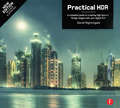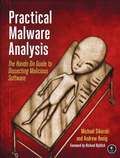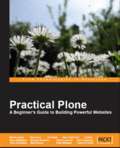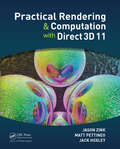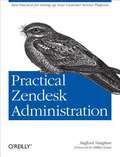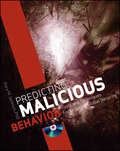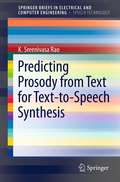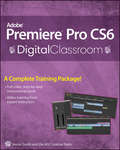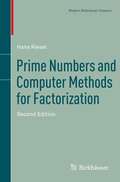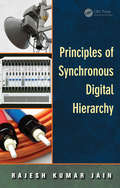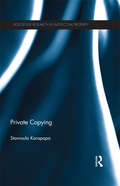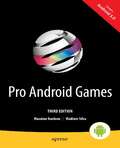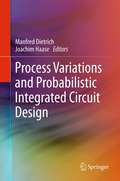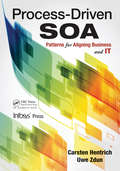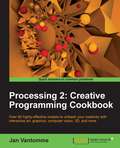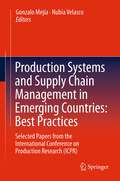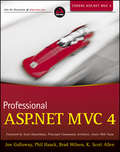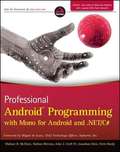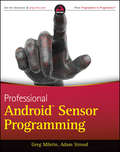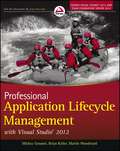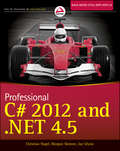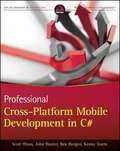- Table View
- List View
Practical HDR (2nd Edition): The Complete Guide To Creating High Dynamic Range Images With Your Digital Slr
by David NightingaleThe first edition of David Nightingale's Practical HDR swiftly established itself as the standard work on this cutting-edge processing technique, garnering rave reviews and reprinting several times. Now, technical advances in the field have expanded HDR's possibilities still further, and this second, expanded edition, revised throughout, will cement David's reputation as the most respected writer in the field.Covering new programs, in particular Adobe CS5's HDR capabilities, and with more killer photos from the world's leading lights in HDR processing, Practical HDR will let the reader create jaw-dropping images that demand a second look.
Practical HDR: A complete guide to creating High Dynamic Range images with your Digital SLR
by David NightingaleHDR is both a technical solution to the limitations of digital camera sensors, and a creative tool that can give any image much more impact - but it is not without its pitfalls, and it's essential to understand these if you want to take full advantage of this innovative technique. The second edition of David Nightingale's successful Practical HDR is completely updated with the latest techniques and technologies in HDR. Practical HDR provides you with an abundance of step-by-step examples that will quickly make you an expert on the theory and practice of shooting and processing HDR images, allowing you to get the best possible results every time. As well as practical advice on shooting and processing, the book also contains a global showcase of inspirational HDR images - you will quickly find that HDR offers unparralleled opportunities for indulging your creative instincts, from photo-realistic to hyper-realism.
Practical Malware Analysis: The Hands-on Guide to Dissecting Malicious Software
by Michael Sikorski Andrew HonigMalware analysis is big business, and attacks can cost a company dearly. When malware breaches your defenses, you need to act quickly to cure current infections and prevent future ones from occurring. For those who want to stay ahead of the latest malware, Practical Malware Analysis will teach you the tools and techniques used by professional analysts. With this book as your guide, you'll be able to safely analyze, debug, and disassemble any malicious software that comes your way. You'll learn how to: Set up a safe virtual environment to analyze malware Quickly extract network signatures and host-based indicators Use key analysis tools like IDA Pro, OllyDbg, and WinDbg Overcome malware tricks like obfuscation, anti-disassembly, anti-debugging, and anti-virtual machine techniques Use your newfound knowledge of Windows internals for malware analysis Develop a methodology for unpacking malware and get practical experience with five of the most popular packers Analyze special cases of malware with shellcode, C++, and 64-bit code Hands-on labs throughout the book challenge you to practice and synthesize your skills as you dissect real malware samples, and pages of detailed dissections offer an over-the-shoulder look at how the pros do it. You'll learn how to crack open malware to see how it really works, determine what damage it has done, thoroughly clean your network, and ensure that the malware never comes back. Malware analysis is a cat-and-mouse game with rules that are constantly changing, so make sure you have the fundamentals. Whether you're tasked with securing one network or a thousand networks, or you're making a living as a malware analyst, you'll find what you need to succeed in Practical Malware Analysis.
Practical Plone 3: A Beginner's Guide to Building Powerful Websites
by Alex Clark Clayton ParkerThis is a beginner's practical guide that doesn't involve any code or programming concepts. You will learn by pointing and clicking on the options available in front of you. It includes easy-to-follow instructions and screenshots that will guide you through creating a powerful website. Each chapter stands alone and you need not go through all the chapters. You can pick and choose depending upon your requirements. If you want to get a Plone site up and running quickly and don't want to get involved in programming, this book is for you. This book is aimed at beginners, who want to configure and customize Plone to meet their content management needs. The book doesn't expect programming skills, although some knowledge of fundamental web concepts such as HTML and HTTP may be helpful.
Practical Rendering and Computation with Direct3D 11
by Jason Zink Matt Pettineo Jack HoxleyDirect3D 11 offers such a wealth of capabilities that users can sometimes get lost in the details of specific APIs and their implementation. While there is a great deal of low-level information available about how each API function should be used, there is little documentation that shows how best to leverage these capabilities. Written by active me
Practical Zendesk Administration
by Stafford Vaughan<p>In this hands-on guide, author Stafford Vaughan provides the most comprehensive set of best practices for setting up and using Zendesk, distilled from years of training companies how to launch this popular customer service software. You’ll learn the purpose, benefits, and pitfalls of each Zendesk feature, with examples of how you can configure it to match your company’s needs and processes.</p>
Pre-Employment Background Investigations for Public Safety Professionals
by Frank A. Colaprete***Author Radio InterviewJoin Dr. Frank A. Colaprete for an upcoming interview on the Privacy Piracy show on KUCI 88.9FM. Click here on September 2nd, 2013 at 8:00 a.m. PST to listen in.Pre-employment investigations have been the subject of intense review and debate since 9/11 made the vetting of applicants a critical function of every organization
Predicting Malicious Behavior
by Gary M. JacksonA groundbreaking exploration of how to identify and fight security threats at every levelThis revolutionary book combines real-world security scenarios with actual tools to predict and prevent incidents of terrorism, network hacking, individual criminal behavior, and more. Written by an expert with intelligence officer experience who invented the technology, it explores the keys to understanding the dark side of human nature, various types of security threats (current and potential), and how to construct a methodology to predict and combat malicious behavior. The companion CD demonstrates available detection and prediction systems and presents a walkthrough on how to conduct a predictive analysis that highlights proactive security measures.Guides you through the process of predicting malicious behavior, using real world examples and how malicious behavior may be prevented in the futureIllustrates ways to understand malicious intent, dissect behavior, and apply the available tools and methods for enhancing securityCovers the methodology for predicting malicious behavior, how to apply a predictive methodology, and tools for predicting the likelihood of domestic and global threats CD includes a series of walkthroughs demonstrating how to obtain a predictive analysis and how to use various available tools, including Automated Behavior AnalysisPredicting Malicious Behavior fuses the behavioral and computer sciences to enlighten anyone concerned with security and to aid professionals in keeping our world safer.
Predicting Prosody from Text for Text-to-Speech Synthesis
by K. Sreenivasa RaoPredicting Prosody from Text for Text-to-Speech Synthesis covers the specific aspects of prosody, mainly focusing on how to predict the prosodic information from linguistic text, and then how to exploit the predicted prosodic knowledge for various speech applications. Author K. Sreenivasa Rao discusses proposed methods along with state-of-the-art techniques for the acquisition and incorporation of prosodic knowledge for developing speech systems. Positional, contextual and phonological features are proposed for representing the linguistic and production constraints of the sound units present in the text. This book is intended for graduate students and researchers working in the area of speech processing.
Premiere Pro CS6 Digital Classroom (Digital Classroom)
by Jerron Smith AGI Creative TeamYou have a personal tutor in the Digital Classroom If you want expert instruction that fits into your schedule, the Digital Classroom series delivers. Expert instructors guide you through 11 lessons, helping you learn essential Premiere Pro CS6 skills at your own speed. Full-color, step-by-step instructions in the book are enhanced with video tutorials at the companion Web site digitalclassroombooks.com. With this Digital Classroom training package, you have your own private instructor showing you the easiest way to learn Premiere Pro CS6. Import video, audio, and still images and edit them together on the Timeline Add transitions and effects to your video to make your projects more engaging and appealing Automatically stabilize shaky footage with the Warp Stabilizer Animate layered Photoshop files to create onscreen graphics Create text and titles using the built-in Premiere Pro Titler Use Adobe Encore to author your projects to disk or for web distribution Note: Video tutorials and other supplementary materials are not included as part of the e-book file, but are available for download after purchase. Instructions are located in the "Starting Up" section.
Prime Numbers and Computer Methods for Factorization
by Hans RieselFrom the original hard cover edition: In the modern age of almost universal computer usage, practically every individual in a technologically developed society has routine access to the most up-to-date cryptographic technology that exists, the so-called RSA public-key cryptosystem. A major component of this system is the factorization of large numbers into their primes. Thus an ancient number-theory concept now plays a crucial role in communication among millions of people who may have little or no knowledge of even elementary mathematics. Hans Riesel's highly successful first edition of this book has now been enlarged and updated with the goal of satisfying the needs of researchers, students, practitioners of cryptography, and non-scientific readers with a mathematical inclination. It includes important advances in computational prime number theory and in factorization as well as re-computed and enlarged tables, accompanied by new tables reflecting current research by both the author and his coworkers and by independent researchers. The book treats four fundamental problems: the number of primes below a given limit, the approximate number of primes, the recognition of primes and the factorization of large numbers. The author provides explicit algorithms and computer programs, and has attempted to discuss as many of the classically important results as possible, as well as the most recent discoveries. The programs include are written in PASCAL to allow readers to translate the programs into the language of their own computers. The independent structure of each chapter of the book makes it highly readable for a wide variety of mathematicians, students of applied number theory, and others interested in both study and research in number theory and cryptography.
Principles of Synchronous Digital Hierarchy
by Rajesh Kumar JainThe book presents the current standards of digital multiplexing, called synchronous digital hierarchy, including analog multiplexing technologies. It is aimed at telecommunication professionals who want to develop an understanding of digital multiplexing and synchronous digital hierarchy, in particular, and the functioning of practical telecommunication systems, in general. The text includes all relevant fundamentals and provides a handy reference for problem solving or defining operations and maintenance strategies. The author covers digital conversion and TDM principles, line coding and digital modulation, signal impairments, and synchronization, as well as emerging systems.
Private Copying (Routledge Research in Intellectual Property)
by Stavroula KarapapaThis book offers an original analysis of private copying and determines its actual scope as an area of end-user freedom. The basis of this examination is Article 5(2)(b) of the Copyright Directive. Despite the fact that copying for private and non-commercial use is permitted by virtue of this article and the national laws that implemented it, there is no mandate that this privilege should not be technologically or contractually restricted. Because the legal nature of private copying is not settled, users may consider that they have a ‘right’ to private copying, whereas rightholders are in position to prohibit the exercise of this ‘right’. With digital technology and the internet, this tension has become prominent: the conceptual contours of permissible private copying, namely the private and non-commercial character of the use, do not translate well, and tend to be less clear in the digital context. With the permissible limits of private copying being contested and without clarity as to the legal nature of the private coping limitation, the scope of user freedom is being challenged. Private use, however, has always remained free in copyright law. Not only is it synonymous with user autonomy via the exhaustion doctrine, but it also finds protection under privacy considerations which come into play at the stage of copyright enforcement. The author of this book argues that the rationale for a private copying limitation remains unaltered in the digital world and maintains there is nothing to prevent national judges from interpreting the legal nature of private copying as a ‘sacred’ privilege that can be enforced against possible restrictions. Private Copying will be of particular interest to academics, students and practitioners of intellectual property law.
Pro Android Games
by Massimo Nardone Vladimir SilvaCombining actionable, real-world source code with graphics, Pro Android Games, Third Edition shows you how to build more sophisticated and addictive Android game apps with minimum effort. Harness the power of the latest Android 5. 0 SDK to bring countless legendary, action-packed PC games to the Android platform. With actionable real-world source code, this one of a kind book shows you how to build more sophisticated and addictive Android game apps, by leveraging the power of the recent advancements found in the new Android 5. 0 software development kit as well as those you've counted on in earlier releases. Multi-touch code gives these games and their players dynamic input and exchange ability, for a more realistic arcade game experience. Faster and better performance offers Android game players a more seamless, fun arcade experience like never before. There is also improved native C/C++ integration with Android's NDK as well, which makes coding, compiling, and converting both productive and efficient with gains in app performance. Pro Android Games, Third Edition features the following improvements: Updates to the latest version of the Android SDK, NDK, plus the latest Android Studio and Eclipse IDEsGreater focus on tablets, ever changing device resolutions, and hardware specsNative game development and hardware accelerated graphicsBigger and better real world engines, such as Quake I and II plus an oldie from the previous edition: DoomCoverage of the new Android TV SDK APIs, UI, UX, multi-touch and multi-tasking features available with the Android 5. 0 releaseAdvanced techniques for improving your game playing experience including better multi-tasking, improved performance optimization, battery management and moreA 'Quake 3D'-like game app case studyYou'll definitely have fun, and perhaps you'll even make some money. Enjoy In the last few years, Android has progressed with the debut of better fonts, new User Interface and Experience (UI/UX) APIs, tablet considerations, multi-touch capabilities, multi-tasking, faster performance, improved battery management techniques, and now the new Android TV SDK Apps for the Android game app developer repertoire.
ProBlogger
by Darren Rowse Chris GarrettAn update of one of the bestselling blogging books, written by two of the world's most successful bloggersThere's a reason why the first two editions of this book have sold thousands of copies worldwide. Written by two of the world's most successful bloggers, it's one of the clearest books out there on how to earn an income from your blog. This new edition gets you up to date on the very latest changes that affect the blogging-for-business landscape. Featuring new material on Twitter, Facebook, and LinkedIn; plus new ways and tools to grow your audience and expand your business beyond your blog, this professional blogger's bible is better than ever. Helps novices choose a blog topic, analyze the market, set up a blog, promote it, and earn revenueGives aspiring bloggers proven techniques and the tools they need to succeed in building a business from their blogsReveals 20 key ingredients for a successful blog postOffers solid, step-by-step instruction on how bloggers actually make money, why niches matter, how to use essential blogging tools and take advantage of social media and content aggregators, how to optimize your advertising, and much moreIncludes techniques for attracting and growing an audience and how to mine new business opportunities beyond your blogWritten by two fulltime professional bloggers, this exciting, updated edition of ProBlogger tells you exactly how to launch and maintain a blog that makes money.
Process Variations and Probabilistic Integrated Circuit Design
by Joachim Haase Manfred DietrichUncertainty in key parameters within a chip and between different chips in the deep sub micron area plays a more and more important role. As a result, manufacturing process spreads need to be considered during the design process. Quantitative methodology is needed to ensure faultless functionality, despite existing process variations within given bounds, during product development. This book presents the technological, physical, and mathematical fundamentals for a design paradigm shift, from a deterministic process to a probability-orientated design process for microelectronic circuits. Readers will learn to evaluate the different sources of variations in the design flow in order to establish different design variants, while applying appropriate methods and tools to evaluate and optimize their design.
Process-Driven SOA: Patterns for Aligning Business and IT
by Uwe Zdun Carsten HentrichProcess-Driven SOA: Patterns for Aligning Business and IT supplies detailed guidance on how to design and build software architectures that follow the principles of business-IT alignment. It illustrates the design process using proven patterns that address complex business/technical scenarios, where integrated concepts of service-oriented architecture (SOA), Business Process Management (BPM), and Event-Driven Architecture (EDA) are required. The book demonstrates that SOA is not limited to technical issues but instead, is a holistic challenge where aspects of SOA, EDA, and BPM must be addressed together. An ideal guide for SOA solution architects, designers, developers, managers, and students about to enter the field, the book: Provides an accessible introduction to basic and more advanced concepts in process-driven SOA Illustrates how to manage the complexities of business aligned IT architectures with detailed examples and industry cases Outlines a step-by-step design process using proven patterns to address complex business/ technical scenarios Integrates SOA, BPM, and EDA into practical patterns promoting SOA 2.0 Describing how to synchronize parallel enterprise processes, the authors explain how to cope with the architectural and design decisions you are likely to encounter when designing and implementing process-driven SOA systems. The decisions are described in the form of software patterns to provide you with a practical guideline for addressing key problems using time-tested solutions.
Processing 2: Creative Programming Cookbook
by Jan VantommeA cookbook with a broad sweep of the topic, through lots of practical and useful recipes that are fun to read and do. This book targets creative professionals, visual artists, designers, and students who have a starting knowledge of the Processing Development environment and who want to discover the next level of Processing. Anyone with a creative practice who wants to use computation in their design process. A basic understanding of programming is assumed. However, this book is also recommended to the non-artistic, looking to expand their graphics and artistic skills.
Production Systems and Supply Chain Management in Emerging Countries: Selected papers from the International Conference on Production Research (ICPR)
by Nubia Velasco Gonzalo MejíaThe book presents several highly selected cases in emerging countries where the production-logistics systems have been optimized or improved with the support of mathematical models. The book contains a selection of papers from the 5th International Conference on Production Research (ICPR) Americas 2010 held on July 21-23 in Bogotá, Colombia. The main topic of the conference was "Technologies in Logistics and Manufacturing for Small and Medium Enterprises" which is perfectly aligned with the realities of emerging countries. The book presents methodologies and case studies related to a wide variety of production/logistics systems such as diary production, auto parts, steel and iron production, and financial services. It is focused but not limited to Small/Medium Enterprises.
Professional ASP.NET MVC 4
by K. Scott Allen Scott Hanselman Jon Galloway Phil Haack Brad WilsonAn outstanding author team presents the ultimate Wrox guide to ASP.NET MVC 4 Microsoft insiders join giants of the software development community to offer this in-depth guide to ASP.NET MVC, an essential web development technology. Experienced .NET and ASP.NET developers will find all the important information they need to build dynamic, data-driven websites with ASP.NET and the newest release of Microsoft's Model-View-Controller technology. <P><P>Featuring step-by-step guidance and lots of code samples, this guide gets you started and moves all the way to advanced topics, using plenty of examples. Designed to give experienced .NET and ASP.NET programmers everything needed to work with the newest version of MVC technology Expert author team includes Microsoft ASP.NET MVC insiders as well as leaders of the programming community Covers controllers, views, models, forms and HTML helpers, data annotation and validation, membership, authorization, security, and routing Includes essential topics such as Ajax and jQuery, NuGet, dependency injection, unit testing, extending MVC, and Razor Includes additional real-world coverage requested by readers of the previous edition as well as a new case study example chapter
Professional Android Programming with Mono for Android and .NET/C#
by John J. Croft IV Jonathan Dick Wallace B. Mcclure Chris Hardy Nathan BlevinsA one-of-a-kind book on Android application development with Mono for AndroidThe wait is over! For the millions of .NET/C# developers who have been eagerly awaiting the book that will guide them through the white-hot field of Android application programming, this is the book. As the first guide to focus on Mono for Android, this must-have resource dives into writing applications against Mono with C# and compiling executables that run on the Android family of devices.Putting the proven Wrox Professional format into practice, the authors provide you with the knowledge you need to become a successful Android application developer without having to learn another programming language. You'll explore screen controls, UI development, tables and layouts, and MonoDevelop as you become adept at developing Android applications with Mono for Android.Answers the demand for a detailed book on the extraordinarily popular field of Android application developmentStrengthens your existing skills of writing applications and shows you how to transfer your talents to building Android apps with Mono for Android and .NET/C#Dives into working with data, REST, SOAP, XML, and JSONDiscusses how to communicate with other applications, deploy apps, and even make money in the processProfessional Android Programming with Mono for Android and .NET/C# gets you up and running with Android app development today.
Professional Android Sensor Programming
by Greg Milette Adam StroudLearn to build human-interactive Android apps, starting with device sensors This book shows Android developers how to exploit the rich set of device sensors—locational, physical (temperature, pressure, light, acceleration, etc.), cameras, microphones, and speech recognition—in order to build fully human-interactive Android applications. Whether providing hands-free directions or checking your blood pressure, Professional Android Sensor Programming shows how to turn possibility into reality. The authors provide techniques that bridge the gap between accessing sensors and putting them to meaningful use in real-world situations. They not only show you how to use the sensor related APIs effectively, they also describe how to use supporting Android OS components to build complete systems. Along the way, they provide solutions to problems that commonly occur when using Android's sensors, with tested, real-world examples. Ultimately, this invaluable resource provides in-depth, runnable code examples that you can then adapt for your own applications. Shows experienced Android developers how to exploit the rich set of Android smartphone sensors to build human-interactive Android apps Explores Android locational and physical sensors (including temperature, pressure, light, acceleration, etc.), as well as cameras, microphones, and speech recognition Helps programmers use the Android sensor APIs, use Android OS components to build complete systems, and solve common problems Includes detailed, functional code that you can adapt and use for your own applications Shows you how to successfully implement real-world solutions using each class of sensors for determining location, interpreting physical sensors, handling images and audio, and recognizing and acting on speech Learn how to write programs for this fascinating aspect of mobile app development with Professional Android Sensor Programming.
Professional Application Lifecycle Management with Visual Studio 2012
by Martin Woodward Mickey Gousset Brian KellerThe authoritative and timely guide to ALM from Microsoft insiders and MVPs Focused on the latest release of Visual Studio, this edition shows you how to use the Application Lifecycle Management (ALM) capabilities of Visual Studio 2012 to streamline software design, development, and testing. Divided into six main parts, this timely and authoritative title covers Team Foundation Server, stakeholder engagement, project management, architecture, software development, and testing. Whether serving as a step-by-step guide or a reference for designing software solutions, this book offers a nuts-and-bolts approach to using Microsoft's flagship development tools to solve real-world challenges throughout the application lifecycle. Coverage includes: INTRODUCTION TO APPLICATION LIFECYCLE MANAGEMENT WITH VISUAL STUDIO INTRODUCTION TO TEAM FOUNDATION SERVER TEAM FOUNDATION VERSION CONTROL TEAM FOUNDATION BUILD COMMON TEAM FOUNDATION SERVER INTRODUCTION TO BUILDING STORYBOARDING CAPTURING STAKEHOLDER FEEDBACK AGILE PLANNING AND TRACKING INTRODUCTION TO SOFTWARE ARCHITECTURE TOP-DOWN DESIGN WITH USE CASE ANALYZING APPLICATIONS USING USING LAYER DIAGRAMS TO MODEL INTRODUCTION TO SOFTWARE DEVELOPMENT UNIT TESTING CODE ANALYSIS, CODE METRICS PROFILING AND PERFORMANCE DEBUGGING WITH INTELLITRACE INTRODUCTION TO SOFTWARE TESTING MANUAL TESTING CODED USER INTERFACE TESTING WEB PERFORMANCE AND LOAD TESTING LAB MANAGEMENT Professional Application Lifecycle Management with Visual Studio 2012 offers a thoroughly revised and updated edition of the leading reference book on ALM.
Professional C# 2012 and .NET 4.5
by Bill Evjen Christian Nagel Jay Glynn Karli Watson Morgan SkinnerIntermediate to advanced technique coverage, updated for C# 2012 and .NET 4.5This guide is geared towards experienced programmers looking to update and enhance their skills in writing Windows applications, web apps, and Metro apps with C# and .NET 4.5. Packed with information about intermediate and advanced features, this book includes everything professional developers need to know about C# and putting it to work.Covers challenging .NET features including Language Integrated Query (LINQ), LINQ to SQL, LINQ to XML, WCF, WPF, Workflow, and Generics Puts the new Async keyword to work and features refreshers on .NET architecture, objects, types, inheritance, arrays, operators, casts, delegates, events, strings, regular expressions, collections, and memory management Explores new options and interfaces presented by Windows 8 development, WinRT, and Metro style apps Includes traditional Windows forms programming, ASP.NET web programming with C#, and working in Visual Studio 2012 with C#Professional C# 2012 and .NET 4.5 is a comprehensive guide for experienced programmers wanting to maximize these technologies.
Professional Cross-Platform Mobile Development in C#
by John Hunter Kenny Goers Scott Olson Ben HorgenDevelop mobile enterprise applications in a language you already know!With employees, rather than the IT department, now driving the decision of which devices to use on the job, many companies are scrambling to integrate enterprise applications. Fortunately, enterprise developers can now create apps for all major mobile devices using C#/.NET and Mono, languages most already know. A team of authors draws on their vast experiences to teach you how to create cross-platform mobile applications, while delivering the same functionality to PC's, laptops and the web from a single technology platform and code-base. Rather than reinventing the wheel with each app, this book provides you with the tools you need for cross-platform development--no new languages needed!Presents an overview of the sea change occurring with the use of enterprise mobile applications and what it means for developersShares the criteria for evaluating and selecting the best option for application architectureReviews tools and techniques for setting up a cross-platform development environmentOffers an introduction to the MonoCross open-source project and pattern for cross-platform developmentPacked with specific software design patterns, development best practices, code examples and sample applications, this must-have book gets you started developing cross-platform mobile apps today.

